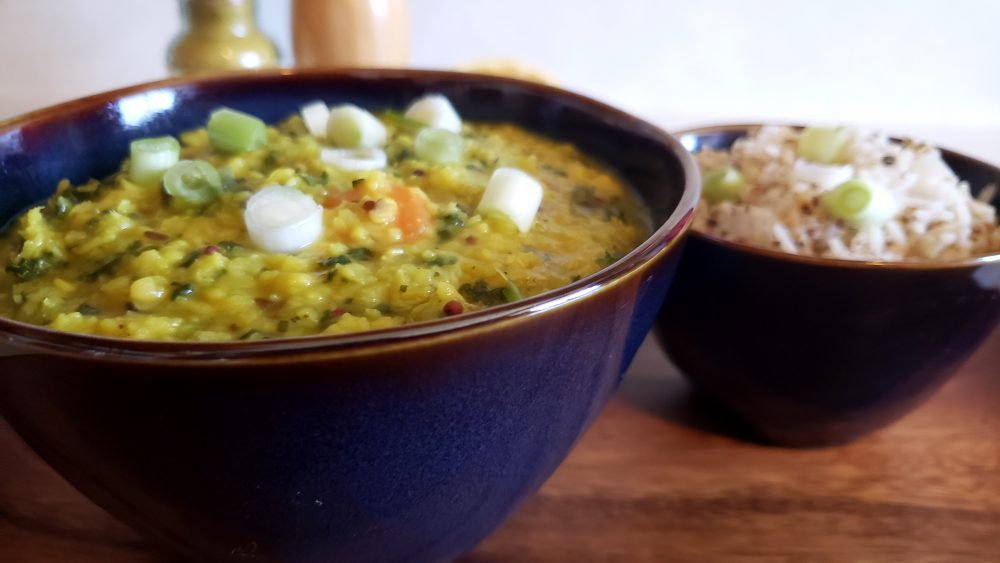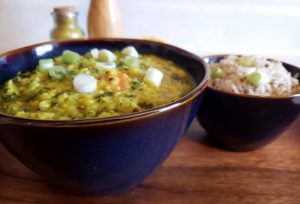 Spring is beginning to blossom as winter comes to an end. Kapha dosha is officially at its climax with colds, cough, congestion, and seasonal allergies becoming more and more prevalent throughout. As we say goodbye to the dark, cool, and heavy qualities that the winter months bring, it becomes more important than ever to welcome more lightening, cleansing, reducing, and stimulating activities and meals into our daily lives. This spicy dal and peppered rice recipe is a wonderful meal option for this time of year as it will undoubtably boost the digestive fire, burn toxins, clear away congestion, and get the blood pumping!
Spring is beginning to blossom as winter comes to an end. Kapha dosha is officially at its climax with colds, cough, congestion, and seasonal allergies becoming more and more prevalent throughout. As we say goodbye to the dark, cool, and heavy qualities that the winter months bring, it becomes more important than ever to welcome more lightening, cleansing, reducing, and stimulating activities and meals into our daily lives. This spicy dal and peppered rice recipe is a wonderful meal option for this time of year as it will undoubtably boost the digestive fire, burn toxins, clear away congestion, and get the blood pumping!
Whether you are looking for more lightness in your life or are focused on performing some deep cleansing for the spring, this spicy dal recipe will be a great addition to help you achieve your goals. It can be used as a staple in your springtime diet to help reduce congestion, boost the digestion and metabolism, energize the system, aid in weight loss, alleviate symptoms of allergies, or ward away cold and flu. If a kitchari cleanse is in your future, this recipe will be equally as beneficial for providing a detoxifying kitchari meal for the duration of your cleanse.
Although this recipe is perfect for the cleansing nature of spring, it can be very healing during the fall and winter months as well. Due to the spicy nature of the recipe, it is fairly Pitta provoking and should be used with caution (or avoided) during the summer months (aka Pitta season). Otherwise it is a great option for both Kapha and Vata types, and may be beneficial for Pitta during the appropriate months and when utilizing the recommended Pitta-specific “optional doshic variations” that are listed below the recipe.
Spicy Dal and Peppered Rice Recipe
Click here for a printable copy of this recipe.
- Doshic effect: Vata ↓, Pitta ↑*, Kapha ↓
- Makes: 8 cups of dal; 4 cups of rice (rice recipe can be doubled if more is preferred)
- Prep Time: 15 minutes
- Cook Time: 40 minutes
- Gluten Free, Vegetarian (can be made vegan)
*This recipe is very heating, however during times of cleansing, sickness, or colder months Pitta types may still benefit as the heat helps to flush out the system, promote sweating, remove obstruction, and detoxify the system. See the optional Pitta variations listed below the recipe to make this recipe more suitable for Pitta types.
Materials
- Medium sauce pan
- Large sauce pan
- Sauté pan for spices
- Spice grinder or mortar and pestle
- Measuring spoons and cups
- Cutting board and knife
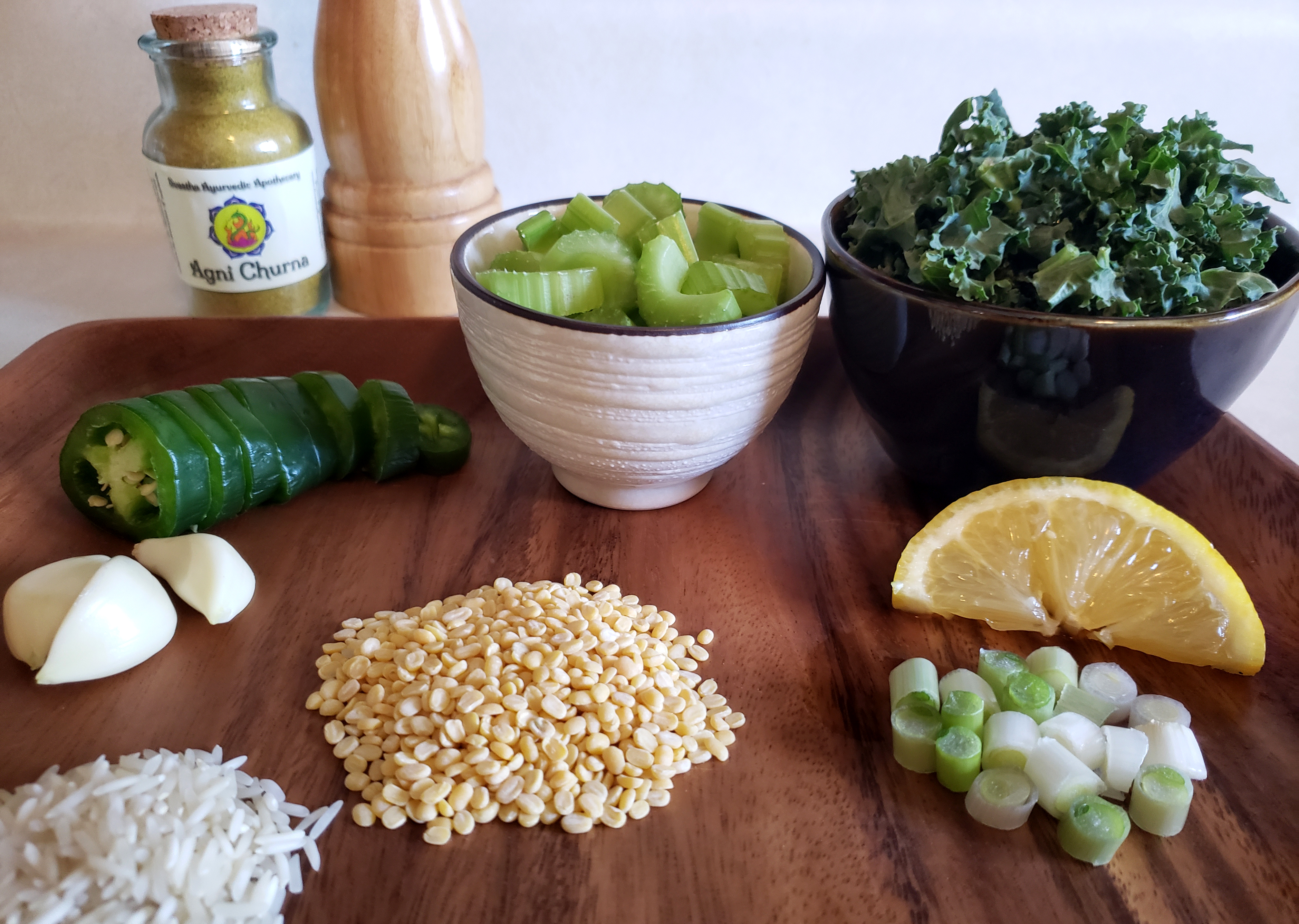
Ingredients
For the rice and seasoning:
- 2 cups water
- 1 cup basmati rice
- 2 teaspoons ghee, divided
- 3 tablespoons sesame seeds (use 2 tablespoons for Kapha)
- 2 teaspoons black peppercorns, whole
- 1 tablespoon cumin seed, whole
- 1 1/2 teaspoons brown mustard seed, whole
For the dal:
- 1 tablespoon ghee
- 1 teaspoon cumin seed, whole
- 1 teaspoon brown mustard seed, whole
- 1/2 teaspoon fennel seed, whole
- 1/4 teaspoon freshly ground black pepper
- 1/4 cup onion, minced
- 1 teaspoon turmeric
- 1 teaspoon ginger powder
- Pinch hing (optional)
- 3 cloves garlic, finely minced
- 1/8 teaspoon cayenne pepper
- 1 medium jalapeno, finely minced
- 6 cups water
- 2 cups red lentils (substitute with mung dal)
- 1 medium carrot, thinly sliced
- 2 celery stalks, thinly sliced
- 3 kale leafs, stemmed and chopped
- 3/4 teaspoon salt
- 1 lemon, juiced
- 1/3 cup chopped cilantro leaf
- Ghee, for individual servings (optional)
- Chopped green onion, for garnish
- Chopped cilantro leaves, for garnish
Click here for a printable copy of this recipe.
Directions
Preparing the Rice:
1. Place the water in a medium sauce pan and bring it to a boil.
2. While waiting, rinse the basmati rice under warm water to wash off any debris and starches.
3. Once the water is boiling, reduce the heat to low and add in the basmati rice and 1 teaspoon of ghee. Stir well and cover the pan, leaving a slight crack in the lid to avoid overflow.
4. Cook here for 12 minutes, covering the lid completely around 6 minutes.
5. Turn off the heat but leave the pan on the hot burner. Add in 1 teaspoon of ghee and stir well. Cover the pan and let it sit for 5 minutes to allow the rice to fluff.
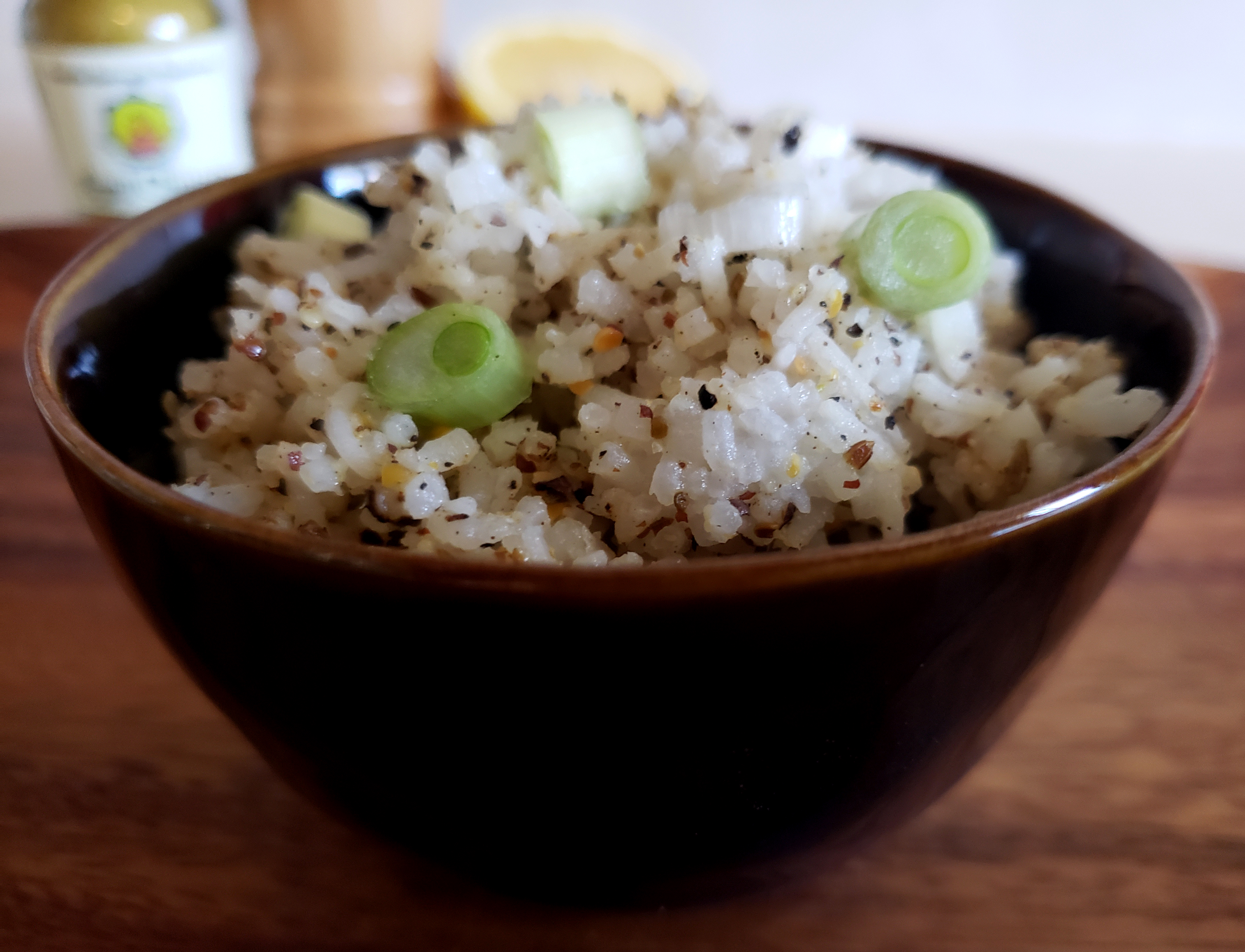
Preparing the Pepper Seasoning (for rice):
1. Place the sesame seeds, black peppercorns, cumin seed, and brown mustard seed in a spice blender and blend for 1 minute until a powder is formed. If a spice grinder is not available, you can use a blender.
2. Heat a small sauté pan over medium heat.
3. Once hot, add in the powdered spice blend and dry roast for 2 to 3 minutes, stirring frequently.
4. Add the powdered spices to the cooked rice and stir until the rice is evenly coated.
5. Cover and set aside until the dal is ready.

Preparing the Dal:
1. While the rice is cooking, begin to cook the dal.
2. Add the ghee to a large sauce pan and turn the heat to medium. Once hot, add in the cumin seed, brown mustard seed, fennel seed, black pepper, and onion. Stirring frequently, sauté these ingredients for 2 minutes.
3. Add in the turmeric, ginger, hing (if used), garlic, cayenne pepper, and jalapeño. Sauté for 30 seconds stirring constantly.
4. Add in the water and bring it to a boil over high heat.
5. Once boiling, reduce the heat to low-medium and add in the red lentils. Cook for 15 minutes with the pan covered, leaving a large crack to avoid overflow.
6. As the beans are cooking, begin to slice up the carrot, celery, and kale.
7. After the 15 minutes, add in the sliced carrots, celery, and kale. Continue to cook over a low-medium heat for an additional 15 minutes stirring every 3 to 4 minutes. If the dal becomes too thick, carefully add more water by the quarter cup.
8. After 15 minutes, reduce the heat to low, cover the pan completely, and cook for a remaining 3 to 5 minutes. Stir every minute to avoid the dal from sticking to the bottom of the pan.
9. Take the pan off of the heat. Add in the salt, fresh lemon juice, and 1/4 cup of chopped cilantro. Stir well until everything is evenly combined.
10. Serve over the peppered rice. Add 1 teaspoon of ghee per serving. Garnish each bowl with green onion and chopped cilantro. Add any additional lemon juice, salt, or pepper if needed.
11. This spicy dal and rice recipe is best during the cooler months of the fall, winter, and early spring. It is a perfect complement to any cleanse, and is healing during times of illness, allergies, sluggish digestion, slow metabolism, weight loss, Kapha imbalance, Vata imbalance, cold, congestion, cough, and flu.
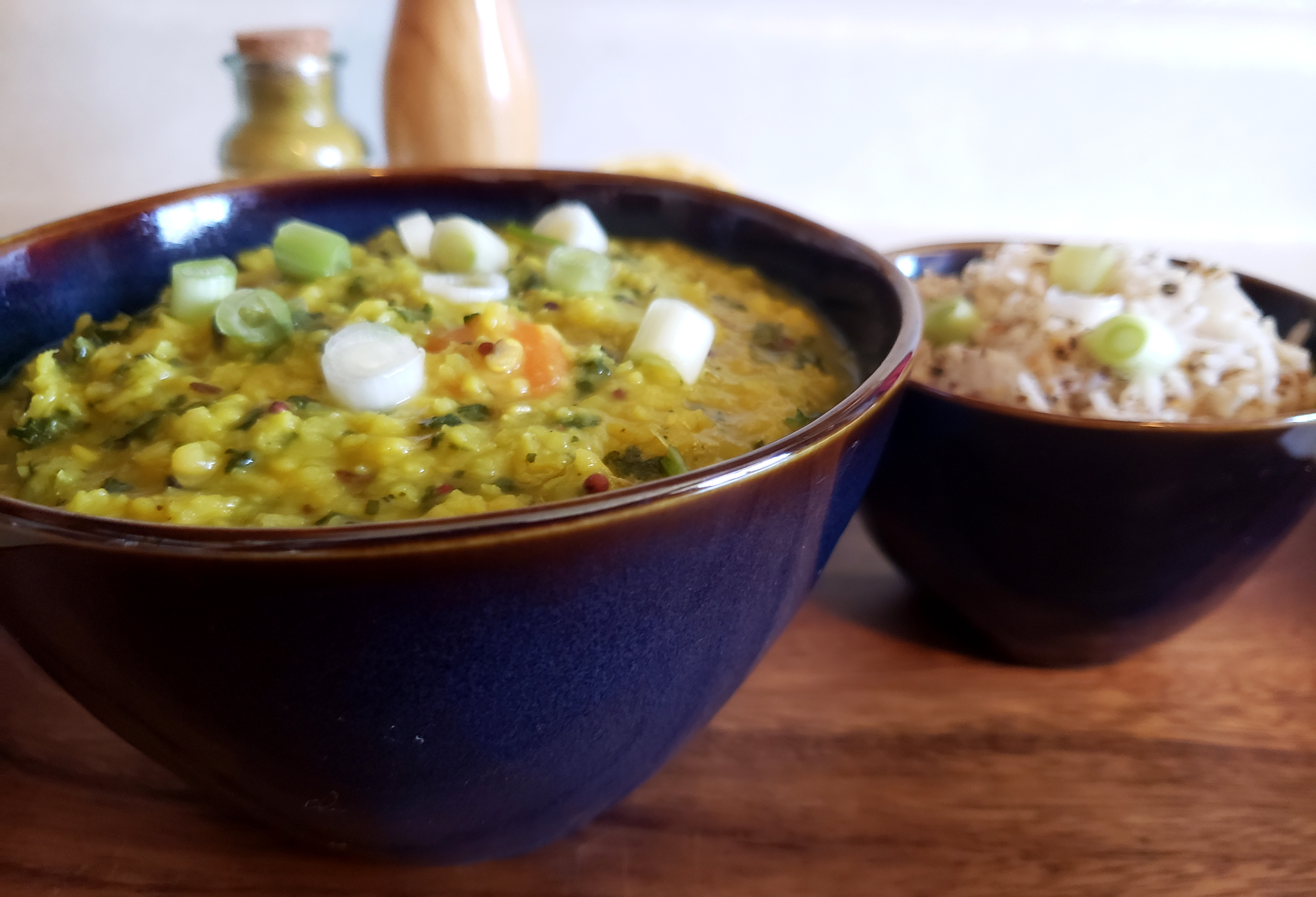
Optional Doshic Variations
Vata:
This recipe is warm, mushy, and well cooked making it a great meal option for Vata types. However, Vata may become excessively dry, gassy, or bloated due to the spicy nature of this recipe and therefore a few changes can be made. The garlic should be reduced to 1 to 2 cloves, the amount of jalapeño can be cut in half, and the dry ginger powder can be replaced with an equal amount of finely grated fresh ginger. Extra ghee can be added as needed. To make this a bit more creamy and nourishing for Vata, one can add in 1 to 2 large spoonfuls of tahini after the cooking process is complete (yummy!!).
Pitta:
This spicy recipe can often be too much heat for fiery Pitta types. For this, omit the cayenne pepper, jalapeno pepper, and hing. Reduce the garlic to one clove. The amount of black pepper and brown mustard seed can be cut in half for both the dal and the rice recipe. The sesame seeds can also be cut in half. The lemon juice should be replaced with lime and the dry ginger should be replaced with an equal amount of finely grated fresh ginger. Extra cilantro should be added along with some shredded coconut (about 1 teaspoon per bowl) to help cool down the recipe.
Kapha:
This recipe is very heating and stimulating making it a great meal option for Kapha types. Everything can remain the same to help pacify Kapha and treat Kapha imbalances (weight gain, congestion, allergies, cough, etc). The only change that may be needed is regarding the basmati rice since grains (especially refined) are often not tolerated by Kapha individuals. In this case one can replace the basmati rice with quinoa. When serving, the dal should be at 2 to 3 parts for every 1 part of grain (whether rice or quinoa). Extra veggies can be added to the dal such as broccoli or cauliflower and extra spices are always welcome (although this recipe is quite spicy as is!). The amount of ghee should be cut in half.

